
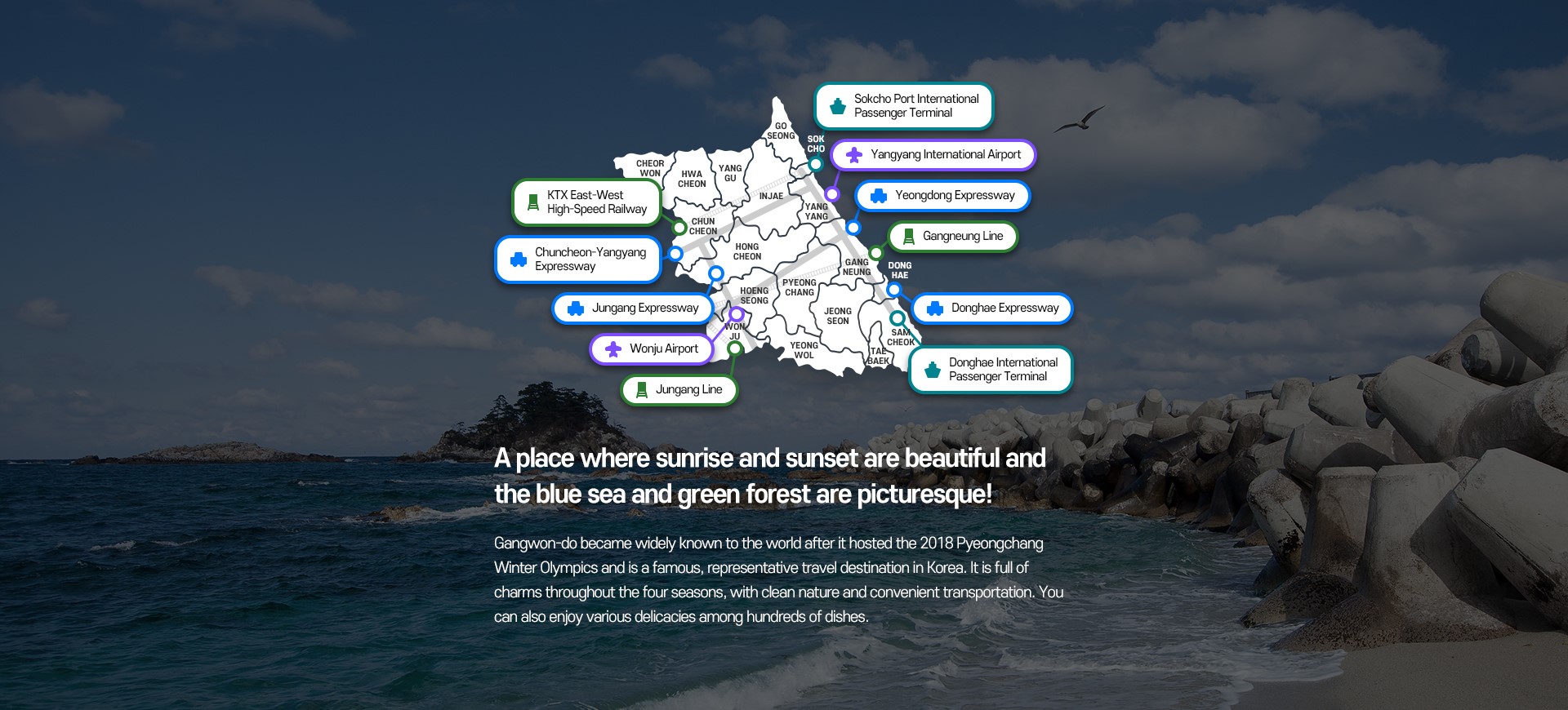
A place where sunrise and sunset are beautiful
and the blue sea and green forest are picturesque!
Gangwon-do became widely known to the world after it hosted the 2018 Pyeongchang Winter Olympics
and is a famous, representative travel destination in Korea.
It is full of charms throughout the four seasons, with clean nature and convenient transportation.
You can also enjoy various delicacies among hundreds of dishes.
Where do you want to go? 
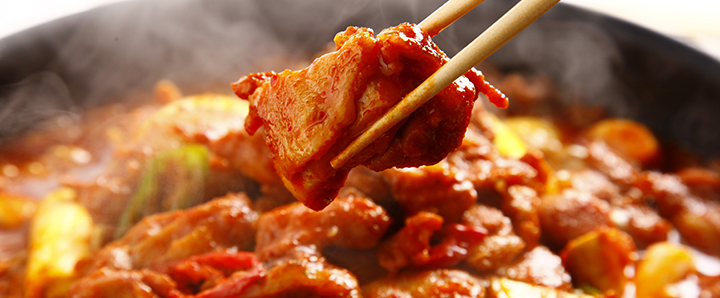
Dakgalbi (Spicy Stir-fried Chicken)Chuncheon
The chicken is fully marinated with the seasoning made of red pepper paste and then stir-fried with vegetables in oil on a hot iron plate. To enjoy the dish, stir-fry seasoned chicken, cabbage, sweet potatoes, and rice cakes on an iron plate. Have vegetables first, then sweet potatoes and chicken in turn. Finally, you can add thick noodles or rice to make stir-fried noodles or fried rice. In Taebaek and Hongcheon, people usually enjoy mul dakgalbi (spicy chicken stew), boiled with broth, and in Chuncheon, people enjoy it stir-fried on a hot plate or roasted it over a charcoal-grill.
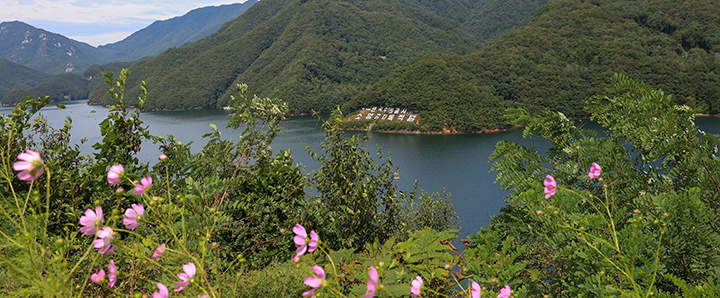
Soyangho LakeChuncheon
Soyanggang Dam is the only multi-purpose dam in the Bukhangang Basin. Clean and clear water flows through large and small valleys in the middle. The forest has diverse tree species; depending on the season, it presents beautiful natural sceneries, such as greenery, autumn leaves, and snow scenery, alongside various wild animals.
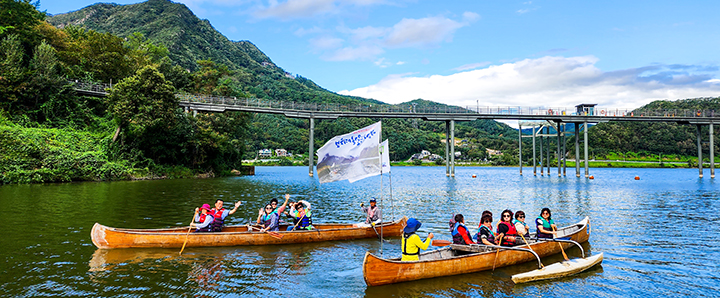
Mulle TrailChuncheon
Here, you can enjoy the beautiful lakeside city of Chuncheon while riding a canoe, which is a special experience of becoming a part of nature. It is popular among friends, lovers, and families alike. The beauty of the Mulle Trail is remembered more clearly at 9 am when the mist rises and at 5 pm when you can enjoy the view of the sunset.
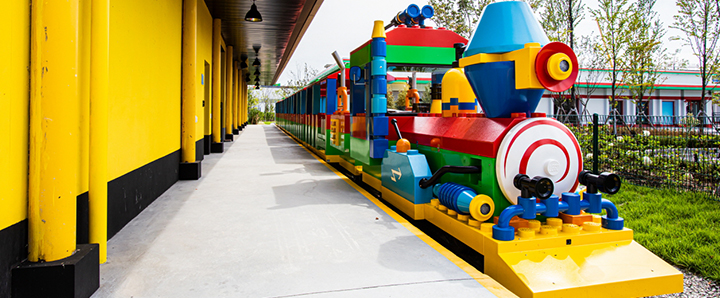
Legoland Korea ResortChuncheon
This is the world's first Legoland built on an island. It is located on Jungdo Island in Chuncheon, a popular LEGO theme park, and hotel among children, families, and lovers. It is the second-largest Legoland in the world and the largest in Asia. Most of the attractions are not provocative and are full of content for children.
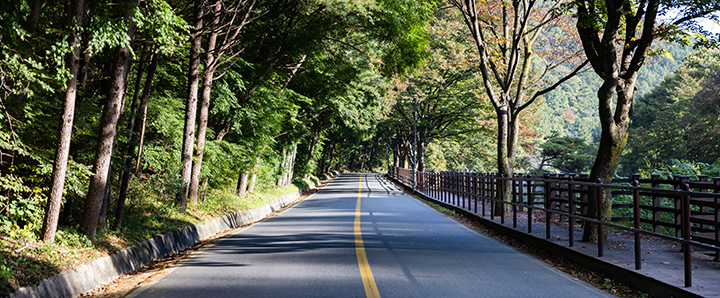
Chiaksan MountainWonju
Chiaksan Mountain has various cultural and ecological heritages along with beautiful scenery. In different places of the mountain, there are cultural resources, such as Guryongsa Temple with Bogwangru Pavilion, tangible cultural property of Gangwon-do, Sangwonsa Temple with the legend of a pheasant, Yeongwonsanseong Fortress, a war relic, Hwangjang Geumpyo (Sign Prohibiting the Logging of Red Pines), a symbol of the logging prohibition, and Seongnam-ri Seonghwangrim Forest, a natural monument No.93, preserved as Korea’s representative temperate forest.
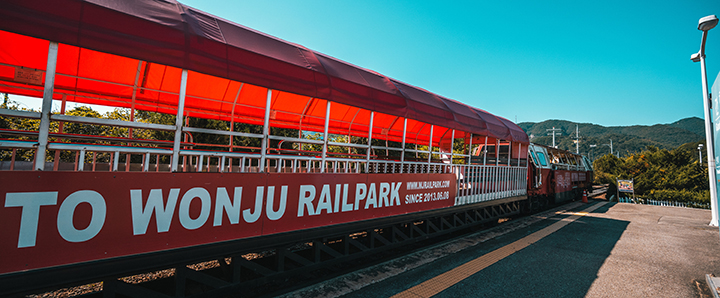
Wonju Rail ParkWonju
It is a romantic date course with a beautiful view. The course itself is a downhill slope. You can enjoy it leisurely without much effort. It is popular because you can enjoy the wonderful natural scenery of Wonju.
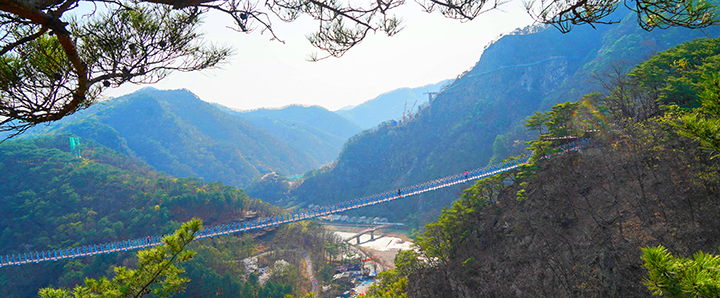
Sogeumsan Grand ValleyWonju
The Ganhyeon Tourist Area with the Sogeumsan Suspension Bridge is a place where the clear water flowing through the Ganhyeon Valley below the Sogeumsan Mountain 343m above sea level, and the refreshing, fantastically shaped rock cliffs create an outstanding view. The largest suspension bridge in Korea, 100m from the ground, gives a thrill to those who cross it.
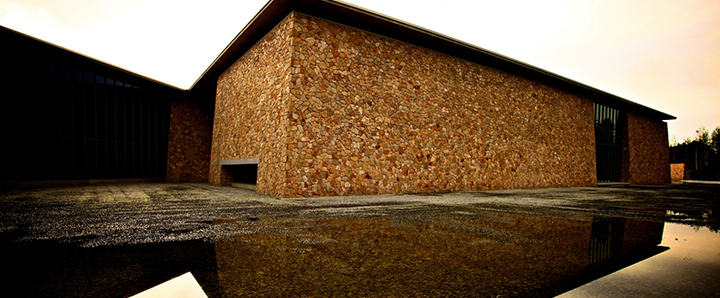
Museum SANWonju
Museum SAN (Space, Art, Nature) is a rustic museum where you can feel the melodies of culture and art in nature's bosom that change every moment of the four seasons. The museum's construction started with the design by ‘Ando Tadao,’ known for nude architecture. It was completed with the last work of the artist 'James Turrell.' It opened in 2013. Especially in autumn, the harmony with the surrounding mountains stands out brightly.
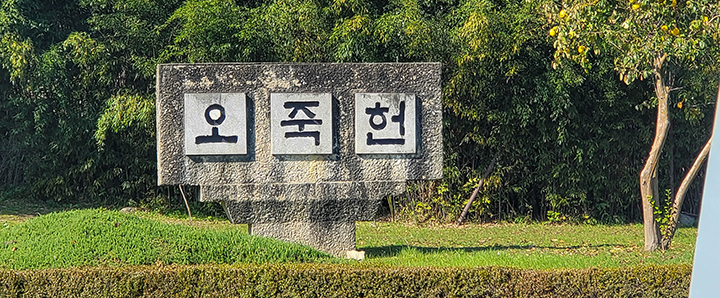
Ojukheon HouseGangneung
Ojukheon House is a building equivalent to a detached house in a private house in the early Joseon Dynasty. It is a flat building with three room spaces from the front and two room spaces from the side, comprised of a hall as large as four rooms, a room as large as two room spaces, and a floor. In addition to the structural value that shows the perfect appearance as a reference material showing houses in the early Joseon Dynasty, Yi I (Yulgok) was born here in Mongryongsil Hall, which adds historic meaning to the building. It was designated as Treasure No. 165 on January 21, 1963.

Gyeongpo BeachGangneung
In spring, the green sea flows from Oribawi Rock and Simnibawi Rock and leaves white traces on the white sand. In summer, you can make memories and enjoy romance by the sea in the scorching heat. In autumn, it becomes the sea where you want to take a quiet walk. In winter, it is the sea where it feels like someone would come to visit you. It changes its image every season, giving tourists a relief and impression.

Wolhwa Street ParkGangneung
In spring, the green sea flows from Oribawi Rock and Simnibawi Rock and leaves white traces on the white sand. In summer, you can make memories and enjoy romance by the sea in the scorching heat. In autumn, it becomes the sea where you want to take a quiet walk. In winter, it is the sea where it feels like someone would come to visit you. It changes its image every season, giving tourists a relief and impression.
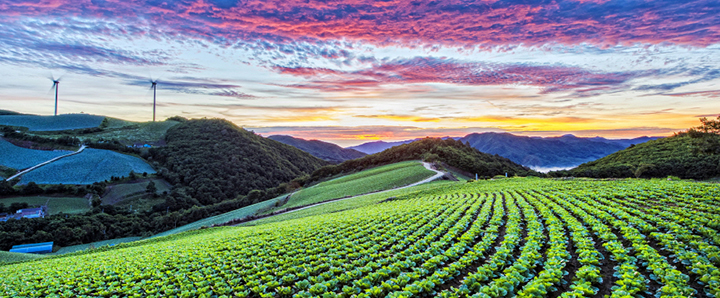
Anbandegi VillageGangneung
In Gangneung, there is a village called Anbandegi, which is referred to as “the first village under the sky” because it is located in an alpine area at an altitude of 1,100m above sea level. 'Anban' means a wide wooden board placed on the bottom when pounding rice dough to make rice cake, and 'degi' means flat ground. The village was named Anbandegi because there is a broad terrain with a hollow like Anban. It is the largest highland vegetable complex in the country, and it has become famous as a tourist attraction because you can see the stars and the Milky Way while auto camping here.
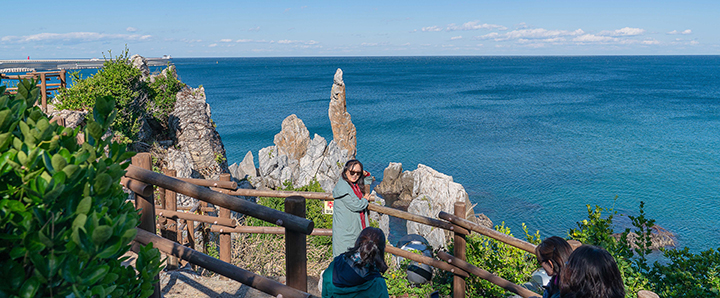
Chotdaebawi RockDonghae
Chogok Coast, which comes in sight at the end of the winding coast that runs from East Coast National Highway 7 through Munam Beach, is where you can see a superb view of the coast created by uniquely shaped rocks. Since it was a military area, it was impossible to go by land. It was a hidden spot where local residents could see it on a fishing boat once in a while. It is easy to reach using the outdoor trail with a suspension bridge, 56m long and 11m tall.

Mangsang BeachDonghae
With the expansion of accommodation and various convenience facilities such as Mangsang Auto Camping Resort with shallow water depth, clean seawater, wide sandy beach, and dense pine forest, it is a perfect tourist destination for all seasons. Seagulls flock across the 4km wide white sandy beach and blue sea. It is one of the coastal tourist destinations linking Gangneung to Samcheok along with the Mukho Port nearby.

Cheongok Golden Bat CaveDonghae
Cheongok Golden Bat Cave is the only cave in Korea located in the city center. The temperature is maintained at 14-15 degrees all year round. You can feel cool in summer and warm in winter. There is also a rest area where you can see the Wildflower Experience Park and the East Sea at a glance alongside Mukho Lighthouse in the distance.
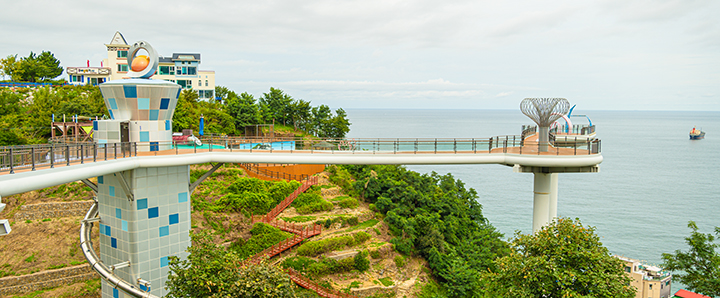
Dojjaebigol Sky ValleyDonghae
It is said that it was called 'Dojjaebigol (goblin valley)' because they say the will-o' the-wisp appears on a rainy day. The Skywalk Observatory, 59m above sea level, was built here and has become a new landmark in Donghae City. It is a travel destination full of thrilling elements such as 'Sky Walk,' Giant Slide, and Sky Cycle.

Maebongsan Windy HillTaebaek
Maebongsan Mountain has a large highland cabbage complex covering a 1.32 km2 area from the foot of the mountain to near the top. It is famous for its hilly sections, where you can see the stars and the Milky Way. If you lay down on a mat in an empty place and look at the stars for a long time, you can occasionally see shooting stars. It should be noted that, as the name suggests, the Maebongsan Windy Hill has strong winds. You must be prepared, especially for the cold. You cannot go by car during the day. You have to take a shuttle bus, but if you are going there to take pictures of the stars at night, you can take your car.
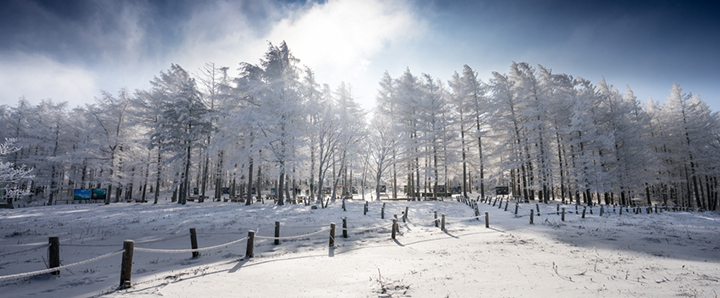
Hambaeksan MountainTaebaek
The vicinity is one of the country's leading coal fields, and the Taebaek Line, an industrial railroad, passes through the northern slopes of the mountain. In Hambaeksan Mountain, there is Jeongamsa Temple, which is said to have been built during the Silla Dynasty. The temple has Sumano Pagoda and habitat for Manchurian trouts.
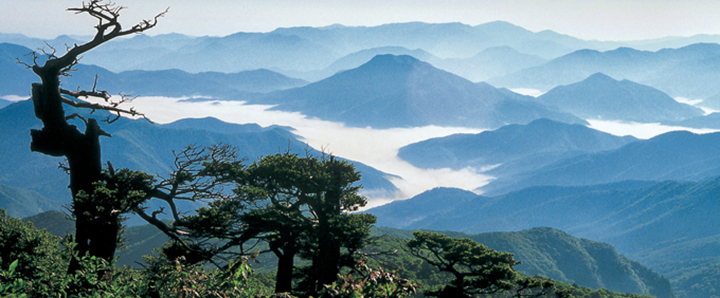
Taebaeksan MountainTaebaek
Taebaeksan Mountain has abundant cultural resources and outstanding ecological scenery, such as the Cheonjedan Altar, where rituals were held for thousands of years, and Geomryongso Spring, the source of the Hangang River. With few rock walls and a slow slope, it is a mountain that can be easily climbed by people of all ages and genders. Alpine plants grow wild on the top, and you can see beautiful azaleas in spring and dazzling white snowflakes in winter.

Taebaek Paleozoic MuseumTaebaek
Taebaek Paleozoic Museum, located in Taebaek, is Korea's first museum specializing in the Paleozoic Era. The museum itself was built on top of the Paleozoic strata. It is a living place of experience where we can look back on the process leading up to the time we live in and enjoy various experiences together.
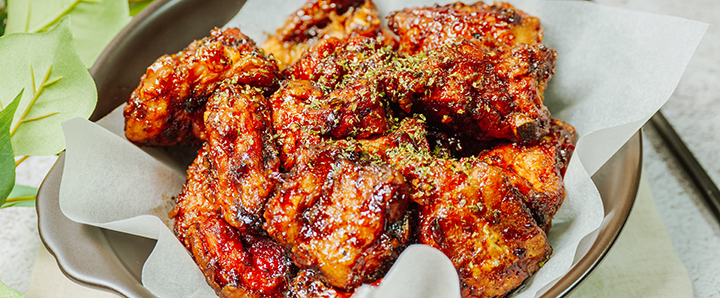
Deep-fried and Braised ChickenSokcho
Sokcho Market, known for a specialty of chicken dishes, from raw chicken to fried and braised chicken, offers unique tastes of chicken dishes that differ slightly in each store due to different frying methods and the ingredients used (sesame leaves, deodeok, dried fruits, etc.). You can choose the one that suits you. Dakgangjeong Alley is one of the must-go places when you come to Sokcho. (Sokcho Tour)
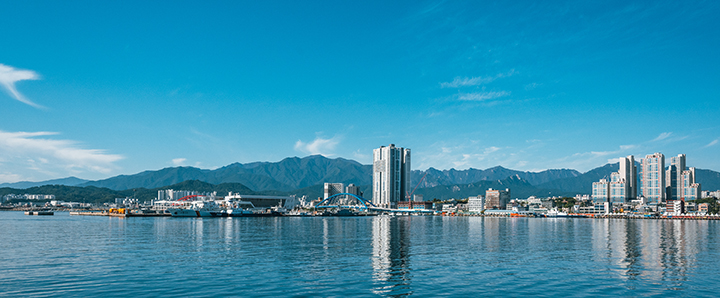
Cheongchoho LakeSokcho
Cheongchoho Lake, also called Ssangseongho Lake or Jinseongho Lake, is the largest lake among lakes and is characterized by its shape resembling a sake pot. The pavilion overlooking the lake is called Cheongchojeong Pavilion, and it adds beauty to the elegant scenery of sunrise. If you look at the orange lake before sunrise, you will forget about the cold winter and fall in love with the wonderful scenery.

Deungdae BeachSokcho
Various photo zones are created, such as a crooked square frame that radiates a refreshing feeling against the cool sea that identifies Sokcho as a tourist destination for all four seasons in the background, a tetra port with intense contrast between hot pink and blue sea, and a love tree that reminds you with overflowing love just by looking at it.

Seoraksan MountainSokcho
You can see the East Sea if you climb up to Ulsanbawi Rock. It is popular among many tourists, and you can climb without hiking boots. It offers colorful scenery in the fall foliage season and white snow scenery in winter.

Gomchiguk (Moray Eel Soup)Samcheok
Moray eels, also called water catfish, are softer and lighter than those from the East Coast. Gomchi Haejangguk (hangover soup), stewed with fermented kimchi, has a spicy and refreshing broth that melts in your mouth.
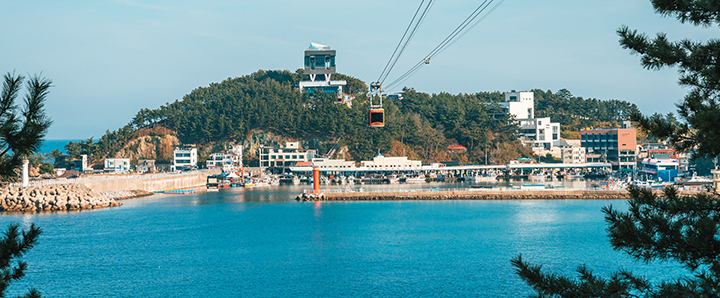
Marine Cable CarSamcheok
You can enjoy the beautiful harbor and the emerald sea view from the air by taking the cable car from Jangho Port, which is called the Napoli of Korea, to Yonghwa-ri. The cable car crosses the sea and runs 874m without an intermediate pylon, and the bottom of the cable car is made of transparent glass for you to enjoy the view of the blue sea under your feet.
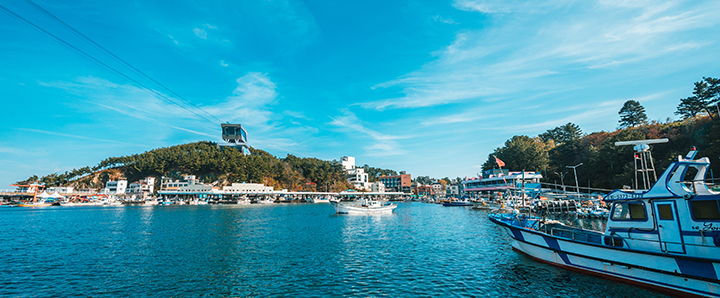
Jangho BeachSamcheok
Located 25km south of Samcheok, it boasts a beautiful white sandy beach along with Yonghwa Beach. In particular, at Jangho Port near the beach, you can taste fresh live fish at a reasonable price. Convenience facilities such as parking lot, campsite, toilet, and shower are relatively well equipped than other places. It is also designated and operated as Jangho Fishing Village with various interactive programs.
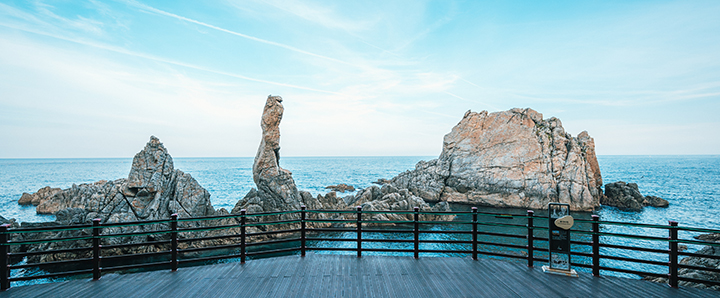
Chotdaebawi RockSamcheok
Chogok Coast, which comes in sight at the end of the winding coast that runs from East Coast National Highway 7 through Munam Beach, is where you can see a superb view of the coast created by uniquely shaped rocks. Since it was a military area, it was impossible to go by land. It was a hidden spot where local residents could see it on a fishing boat once in a while. It is easy to reach using the outdoor trail with a suspension bridge, 56m long and 11m tall.
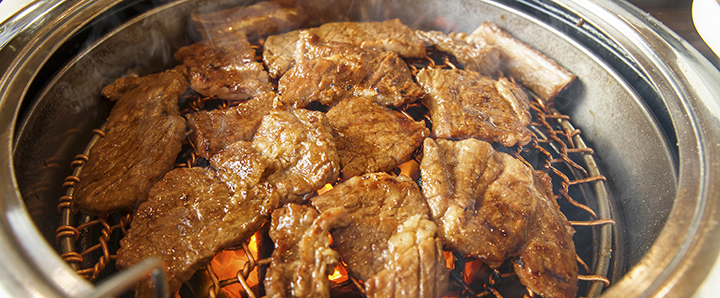
Hwaro Gui (Brazier-grilled Dish)Hongcheon
The brazier-grilled dish you can taste at Yangjimal, Hongcheon, does not have the particular odor of pork and is seasoned with local honey, so you can enjoy the sweet taste without repulsion. The taste of deodeok (herb root) mixed with the same seasoning is also excellent. It is famous as a must-visit place in Hongcheon as it boasts a unique taste that is so good that several similar grills opened around it. (Excerpt from Hongcheon Tour)
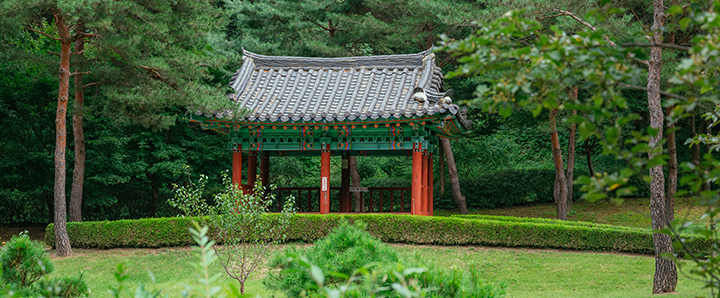
Sutasa Temple Gongjaksan Eco ForestHongcheon
Cherry trees are planted on the way to Sutasa Temple to offer the scenery of cherry blossoms around May. On the way to the temple, you can enjoy an eco-cultural experience with Sutasa Temple, a thousand-year-old temple, and Gongkaksan Eco Forest. Beautiful valleys spread throughout the course for you to enjoy various natural scenery throughout the year.
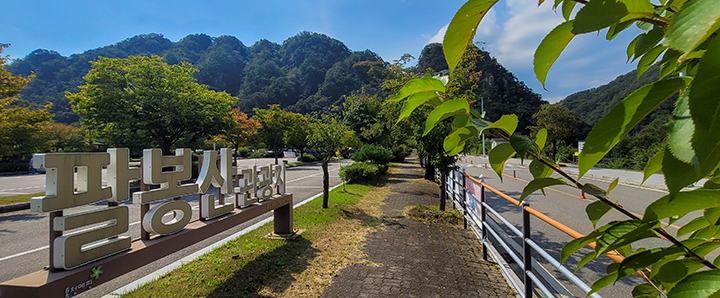
Palbongsan MountainHongcheon
It is a short mountain 328m above sea level. It is called Palbongsan Mountain because it is composed of eight peaks. It is suitable for climbing mountains in spring/autumn and enjoying holidays in summer. The clean and clear Hongcheon River blends in with the wide white sandy beach to preserve a picturesque view. The mountain is low and suitable for family hiking. The white sandy beach is good for camping.

Alpaca WorldHongcheon
It is the only zoo in Korea where you can directly feed or touch the alpaca in a place that reproduces the ecological environment of the alpaca’s habitat. The ‘Alpaca Healing Walk’ program is also popular, and it is interesting to find various animals such as deer, sheep, pony, camel, rabbit, ostrich, parrot, peacock, and eagle.
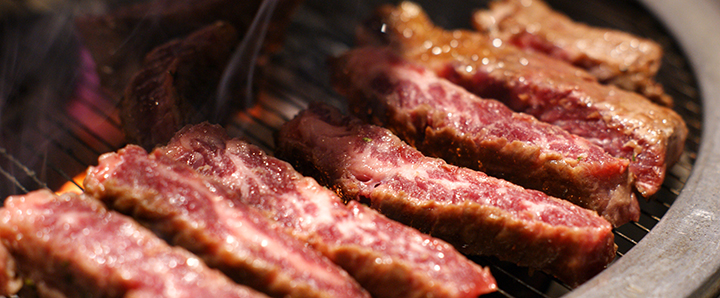
Hanu (Korean Beef)Hoengseong
The high daily temperature difference, clean water at the source of the Seomgang River, and clean environment make it an optimal place for breeding Korean native cattle. Hoengseong Hanu is quite juicy and has excellent taste and a chewy texture. Due to its high content of unsaturated fatty acids, it maintains soft meat quality and rich juice even after heating.
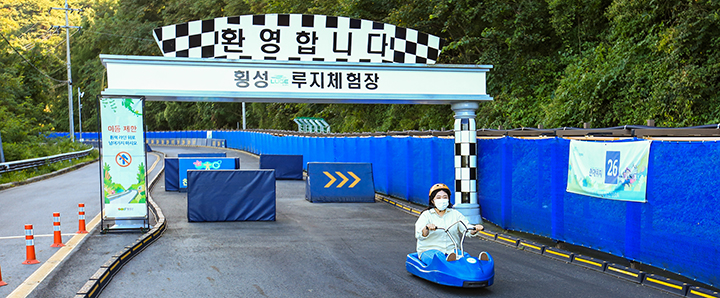
Sutasa Temple Gongjaksan Eco ForestHoengseong
Cherry trees are planted on the way to Sutasa Temple to offer the scenery of cherry blossoms around May. On the way to the temple, you can enjoy an eco-cultural experience with Sutasa Temple, a thousand-year-old temple, and Gongkaksan Eco Forest. Beautiful valleys spread throughout the course for you to enjoy various natural scenery throughout the year.
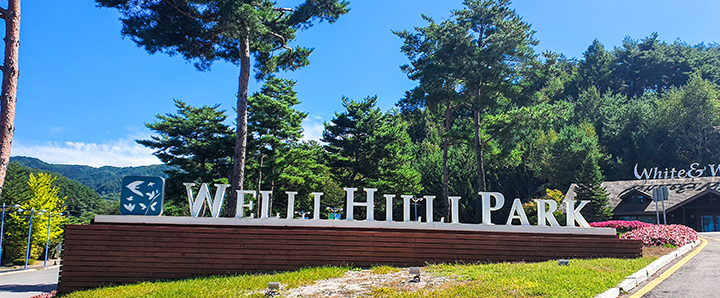
Welli Hilli ParkHoengseong
It is an all-season resort in the outskirts of the city where you can enjoy the unique beauty of each season and feel comfortable in an upgraded relaxing space in splendid nature. By making the best of the natural conditions, you can enjoy a panoramic view of the slopes from your room, and there are a variety of accommodation facilities, international-grade ski slopes, and a membership golf course.
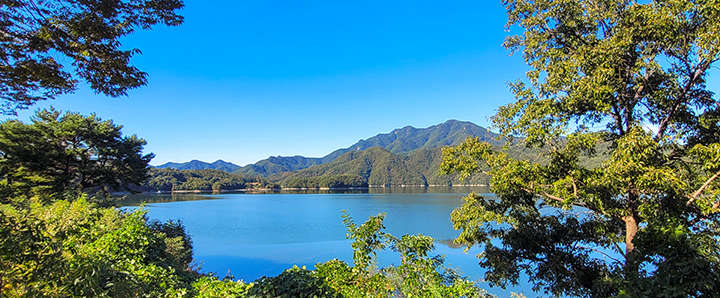
Hoengseong lakeHoengseong
It is a great driving course from Hoengseong-eup to the dam. The hiking course around it is also perfect as it offers a full view of the dam. If you look down from the Hwaseongjeong Pavilion, you can grasp a view close to an oriental painting due to the wet fog.
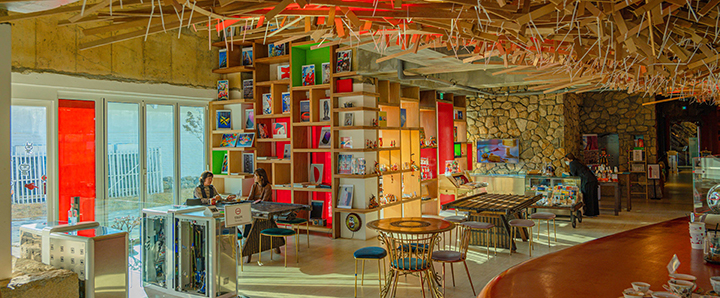
Youngwol Y ParkYeongwol
It is a complex cultural space that opened in June 2019 by remodeling the Sulsaem Museum, a hot place in Yeongwol that emerged as a shrine for social media. ‘Youngwol’ is a coined word combining the English ‘young’ and the word for ‘moon.’ It is divided into 11 areas, and it is interesting to note that most of the facilities are colored in red.
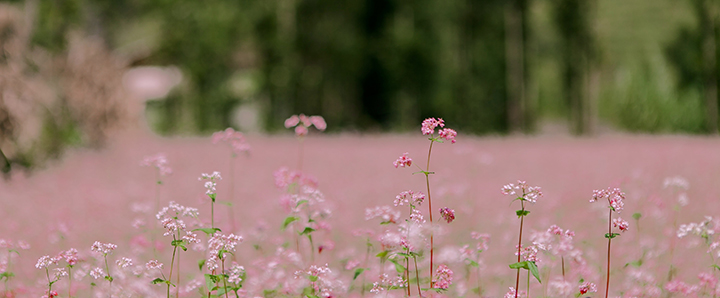
Red buckwheat fieldYeongwol
A place where buckwheat fields turn red in autumn. The blue light and red buckwheat fields of the Yeongwol Donggang River meet to have colorful beauty and pleasure.
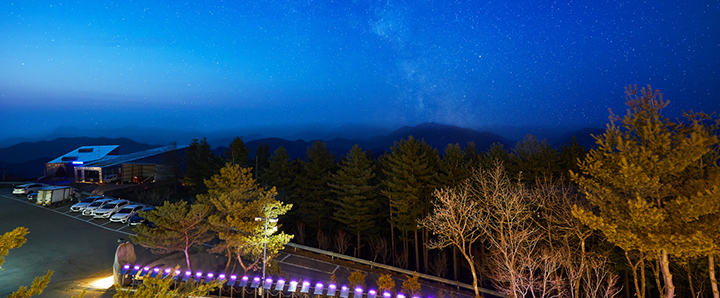
Byeolmaro ObservatoryYeongwol
While the average number of stargazing days in Korea is 100 days, it is 160-190 days in Yeongwol. It is a literally star-studded place. ‘Byeolmaro Observatory’ is a representative attraction in Yeongwol, and its name means ‘a quiet mountain top where you can see the stars.’ It is located at an altitude of 799.8m above sea level, which is the best condition for a public observatory. The name Byeolmaro is a combination of ‘byeol’ meaning star, ‘maru’ meaning top, and ‘ro’ meaning quietness.
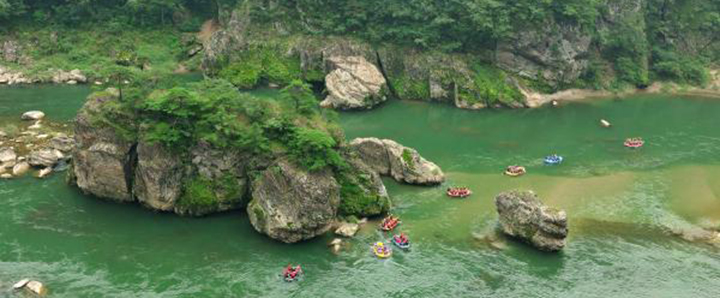
Donggang RiverYeongwol
Donggang River is always lively. It has optimal conditions for enjoying various leisure sports, and the downstream area is suitable for children to play in the water. The Yeongwol Donggang Festival is held every year from July to August, and the winter festival is held from December to January. Various things can be enjoyed through multiple interactive programs, such as lure fishing, paragliding experience, and snow sledding.

Hanu (Korean Beef)Pyeongchang
The high daily temperature difference, clean water at the source of the Seomgang River, and clean environment make it an optimal place for breeding Korean native cattle. Pyeongchang Hanu is quite juicy and has excellent taste and a chewy texture. Due to its high content of unsaturated fatty acids, it maintains soft meat quality and rich juice even after heating.

Cheongoksan Yukbaek MajigiPyeongchang
The place where you can enjoy romance, lying down and looking at the myriads of stars that fill the night sky, is ‘Pyeongchang Yukbaek Majigi.’ Yukbaek Majigi on the Swiss-like landscape of Cheongoksan Mountain, is famous for auto camping, where you can see the Milky Way and the stars. When the night falls in the vast field at an altitude of 1,256m, lie down and look at the stars to feel like you are lying in a different world. You should make impressive memories at Yukbaek Majigi, where you can see the beautiful stars and the Milky Way.
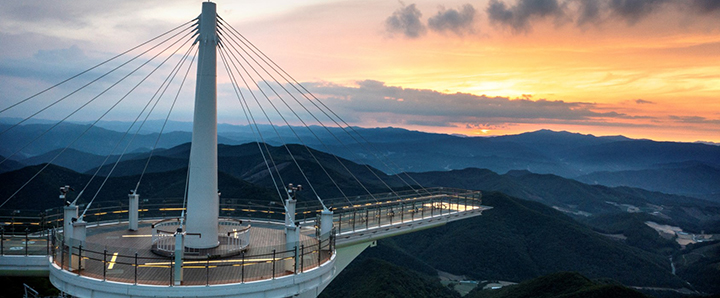
Balwangsan SkywalkPyeongchang
It was built on the highest point among the skywalks in Korea, and there is a turntable that rotates 360 degrees for you to enjoy the panoramic view of the surrounding area. There are three trails at the top of Balwangsan Mountain: ‘Baram-gil,’ ‘Balwangsu Garden Deck Road,’ and ‘Jumok Healing Forest Path.’
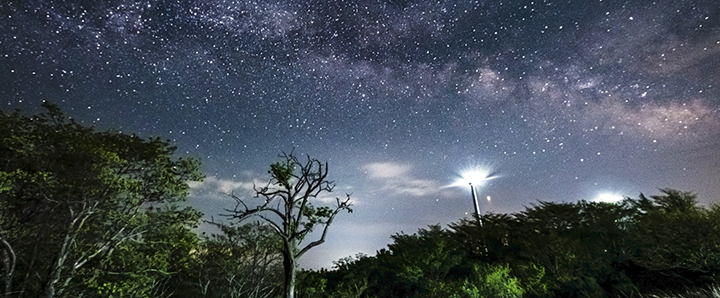
Cheongoksan MountainPyeongchang
The ridgeline is relatively flat on this mountain. “Yukbaek Majigi (Six Thousand Square Meters),” meaning an area good enough for planting 600 rice seeds, is located on the top of the mountain. It is mainly used to cultivate highland vegetables. The hike takes about five hours, and the Main Temple of Three Deities is located near the top of the mountain to welcome hikers. (Source: Every Corner of Korea)
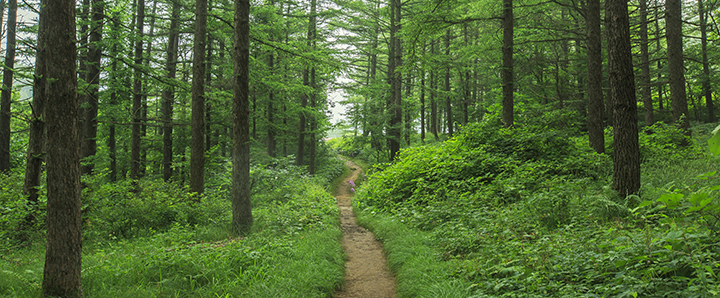
Hambaeksan MountainJeongseon
The vicinity is one of the country's leading coal fields, and the Taebaek Line, an industrial railroad, passes through the northern slopes of the mountain. In Hambaeksan Mountain, there is Jeongamsa Temple, which is said to have been built during the Silla Dynasty. The temple has Sumano Pagoda and habitat for Manchurian trouts.
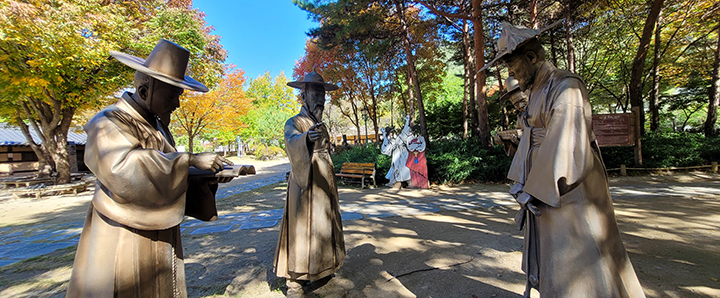
Arari VillageJeongseon
This place was created to capture the lifestyle of Jeongseon Arirang (folk song). Traditional Korean houses around it add elegance and pleasure to the eyes to the place. There are statues based on the famous novel ‘Yangbanjeon (The Story of Noblemen)’ by Park Ji-won, a literary man of Joseon, alongside facilities such as a watermill, farm implements, and a workshop.
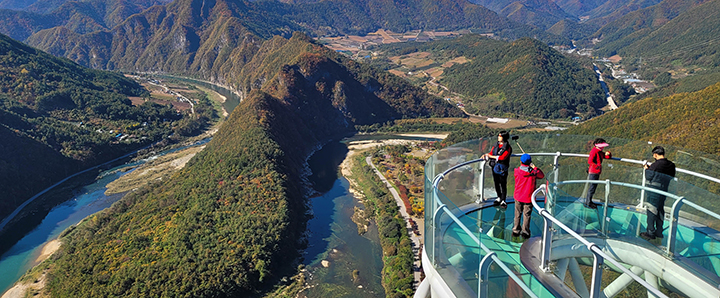
Ari HillsJeongseon
Jeongseon Ari Hills is where the members of BTS move down on a zip wire in the '2021 BTS Winter Package' video. It is full of thrilling activities such as the Sky Walk, Zip Wire, and Zip Coaster.
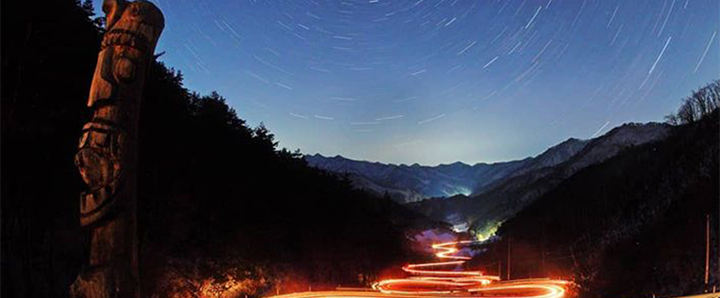
Munchijae HillJeongseon
Munchijae, which has the meaning of a ‘door to the northeast village’ surrounded by mountains over 1,000m above sea level, is famous for Jeongseon’s drive course that winds twelve times. If you look down from the observatory, it winds like a snake coiled up, and the end of the road looks quite distant. It is charming as a curved road that is tougher than an ordinary winding road, but at night, the North Star can be seen in front of the road, which makes it a popular spot to photograph the trace of the star.

Jiktang FallsCheorwon
It is a waterfall made of straight strange rocks between the strange rocky cliffs of the Hantangang River gorge. It is the widest waterfall in Korea and is also called "Korea's Niagara Falls."
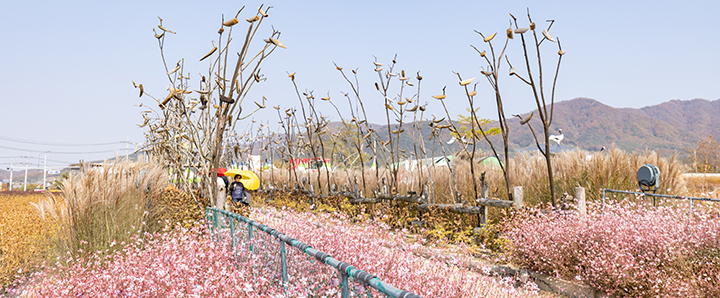
Goseogjeong Flower GardenCheorwon
In the past, it was a training ground for soldiers, planting colorful flowers and trees, and now it is a flower garden. Enjoy taking pictures in the pretty flowers every fall.
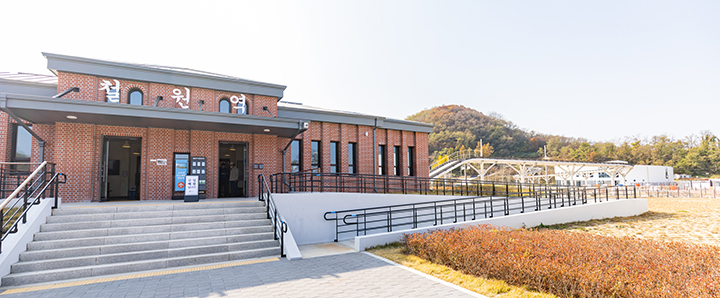
Peace/Mulbit NuriCheorwon
There is a marina at Paroho Amusement Park, where you can enjoy the beautiful scenery of Paroho Lake on Mulbit Nuri (boat). If you follow the blue Paroho Lake, which is like a watercolor painting, you will arrive at the World Peace Bell Park. The Peace Bell is made by collecting bullet casings, shells, and metal fittings from weapons used in actual warfare.
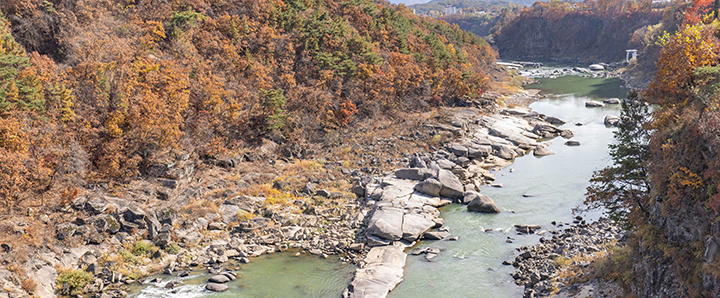
Chou Kyong Chol ObservatoryCheorwon
A place where you can see the Milky Way only about an hour from Seoul is the ‘Chou Kyong Chol Observatory’ in Hwacheon. This pollution-free and clean area at the top of Gwangdeoksan Mountain boasts the highest altitude, 1,010m above sea level, among public observatories in Korea. It is an observatory constructed to commemorate the achievements of Dr. Chou Kyong-chol, also known as “Dr. Apollo.” It is popular because you can see the Milky Way even with the naked eye. One of the charms of this place is that you can feel the beautiful Gwangdeoksan Mountain in all four seasons and at night.
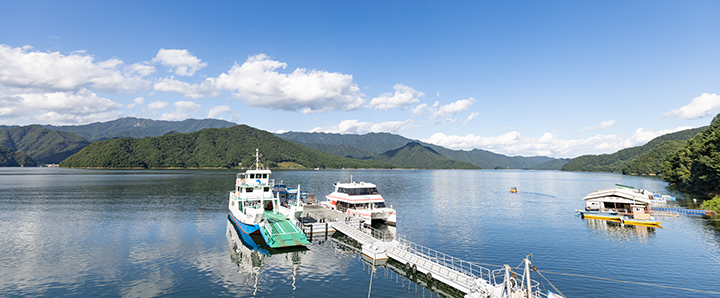
SoyanghoHwacheon
As the only multi-purpose dam in the Bukhangang River basin, clear and clean water flows to the center along small and large valleys. There are also various forest species, so not only the natural scenery such as greenery, autumn leaves, and snowy scenery is beautiful depending on the season, but also various wild animals live there.
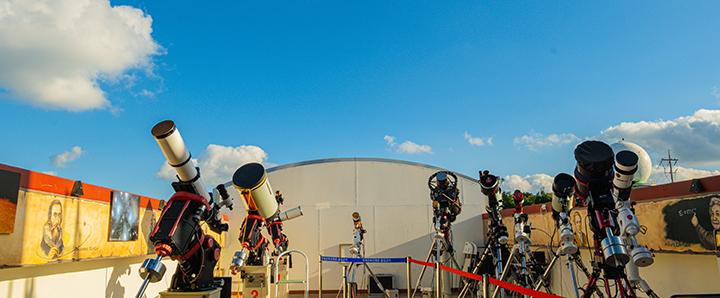
GongjicheonHwacheon
As the only multi-purpose dam in the Bukhangang River basin, clear and clean water flows to the center along small and large valleys. There are also various forest species, so not only the natural scenery such as greenery, autumn leaves, and snowy scenery is beautiful depending on the season, but also various wild animals live there.

Oxygen RoadHwacheon
Hwacheon Oxygen Road is a waterfront trekking course where you can enjoy the nature-friendly scenery of the Bukhangang River. You can have a unique experience of walking on the river while crossing the bridge installed on the river, and you can also walk on the forest path of the primeval forest.

Paroho LakeHwacheon
Paroho Lake referred to as the sea in the mountains for its blue color, was a North Korean territory at the time of the National Liberation in 1945 and then became a South Korean territory after the Korean War. You can take a tour of Paroho Lake on a boat called Mulbit Nuri. Listening to the captain's explanation, it takes about 1 hour and 30 minutes to reach the Peace Dam through the Otter Research Center, Dongchon-ri, and Bisugumi Village.
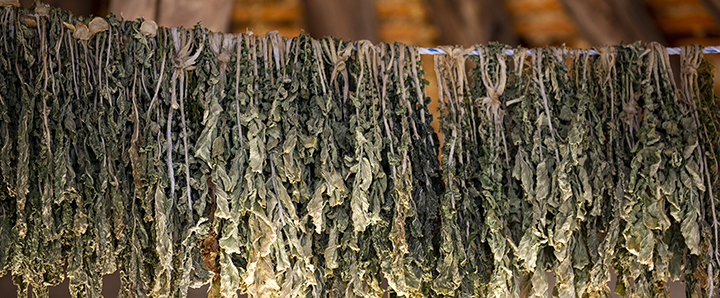
Dried Radish Leaf Yanggu
Siraegi is prepared by drying green radish on a thread throughout the winter. To cook, it is boiled for a long time and soaked in cold water to make various side dishes. It is known for its unique savory taste and soft texture. Radish, the raw ingredient of Siraegi, contains a lot of ingredients that prevent cancer in the radish tops; it is good for preventing various cancers and also excellent for detoxifying liver. Siraegi (dreid radish green) is in season from October to December and is rich in taste and nutrients. Siraegi of Yanggu is grown in the optimized environment with a large daily temperature difference. Siraegi can be enjoyed as siraegi rice and siraegi soybean paste soup in winter. (Official Blog of Yanggu Tourism and Culture)
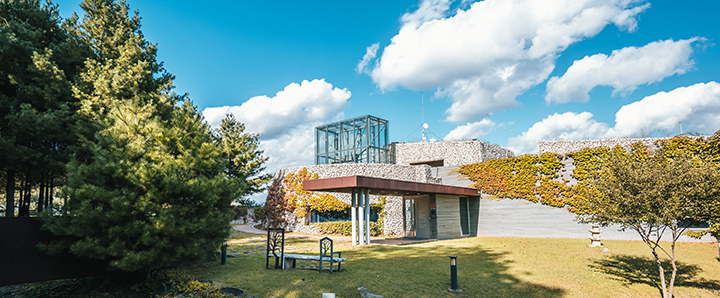
Park Soo Keun Museum Yanggu
Park Soo-keun, the master of the modern Korean painting, achieved a unique style of painting by expressing the daily lives of our people in simple and rough textures. A museum dedicated to his life and art world is located on the site of his birthplace. The exhibits include the works, mementos, and related books of artist Park Soo-keun.
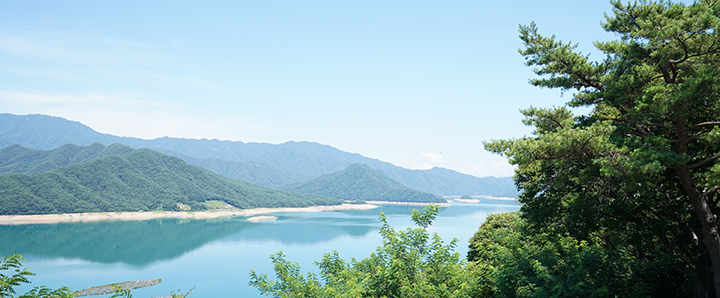
Paroho LakeYanggu
Paroho Lake referred to as the sea in the mountains for its blue color, was a North Korean territory at the time of the National Liberation in 1945 and then became a South Korean territory after the Korean War. You can take a tour of Paroho Lake on a boat called Mulbit Nuri. Listening to the captain's explanation, it takes about 1 hour and 30 minutes to reach the Peace Dam through the Otter Research Center, Dongchon-ri, and Bisugumi Village.

Dutayeon PoolYanggu
It is located on a tributary of the Suipcheon Stream in Geonsol-ri, Bangsan-myeon, north of the Civilian Access Control Line. It is also downstream of Bia-ri and Sae-ri in Dong-myeon. Although there is not much water flowing, the surrounding mountains form a beautiful landscape. Since it is not polluted, it is known as the largest habitat in Korea for Manchurian trout, a natural monument.

Seoraksan MountainInje
You can see the East Sea if you climb up to Ulsanbawi Rock. It is popular among many tourists, and you can climb without hiking boots. It offers colorful scenery in the fall foliage season and white snow scenery in winter.
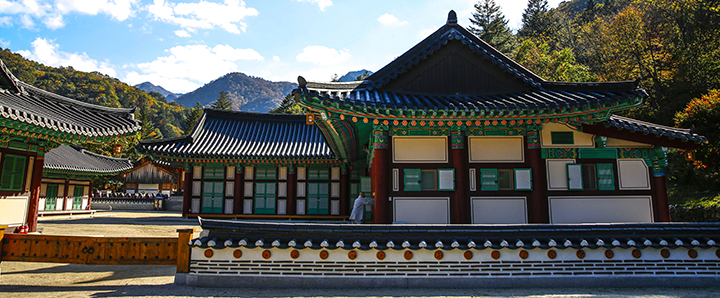
Baekdamsa (Temple)Inje
It is a temple built in 647 during the reign of Queen Jindeok of Silla. When the temple, which was completely destroyed by the Korean War, was rebuilt for the 11th time in 1957, it was named "Baekdamsa Temple" to mean that there are 100 puddles from Daecheongbong Peak of Seoraksan Mountain to the temple.

Naerincheon RaftingInje
Rafting is a leisure sport where many people get on boats made with PVC or rubber to ride the rapids or waves. Visitors can improve their health, gain a challenging spirit, and learn wisdom of life such as trust in other people and adapting to nature.
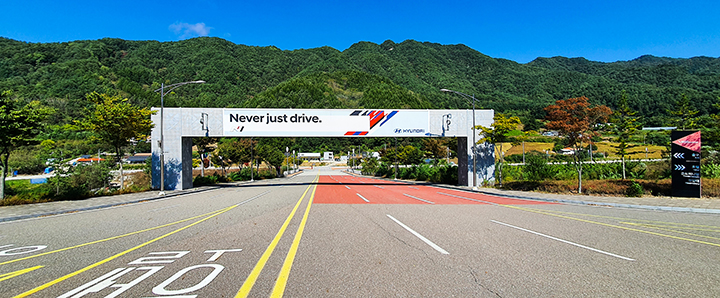
SpeediumInje
It has international standard racetracks and accommodations such as hotels and condos. Ordinary people can enjoy the circuit like professional racers. There are experience programs such as ‘Circuit Kart’ which allows you to enjoy the speed of 150 km/h, and ‘Circuit Safari’ which lets you enjoy the thrilling speed in your own vehicle without a circuit license.
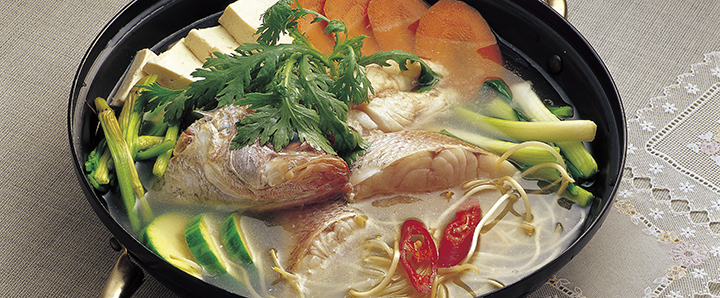
Myeongtaetang (Pollock Soup)Goseong
It is a soup made by boiling pollock with only garlic and salt. It is a low-fat dish rich in calcium and protein. Pollock is one of the most consumed ingredients in Korea, and it is enjoyed as soup or stew or seasoned as a side dish. When prepared as a soup, it is divided into a spicy soup with spicy broth and a clear soup without adding any spicy seasoning. Vegetables such as green onion, garlic, radish, bean sprouts, and water parsley are added to create a refreshing taste and remove the fishy smell.
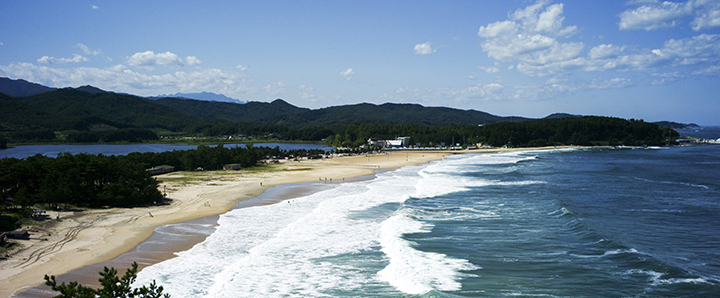
Hwajinpo Habyeon BeachGoseong
It is a beach located at the northernmost tip of the East Coast, where the water is clean and shallow. The strangely shaped rocks look mysterious. The broad Hwajinpo Lake is surrounded by lush pine forests like a folding screen, along with a beautiful beach with natural scenery. There is Kim Il-sung's villa, the first president Rhee Syngman's villa, Lee Ki-bung's villa, and the Hwajinpo Maritime Museum in the area. The bamboo grove of Geumgudo Island, sitting calmly in the East Sea, and the seagulls flying above create a superb view.
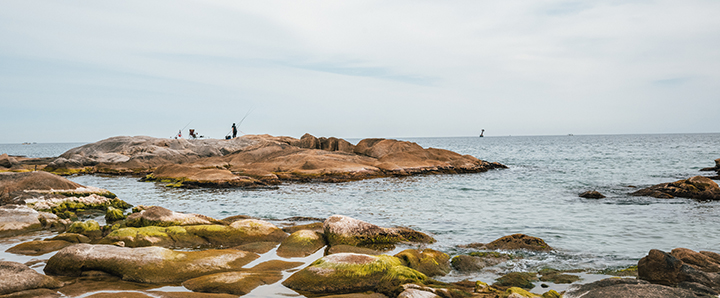
Ayajin BeachGoseong
Ayajin Beach, with its stunning scenery, is a place where large and small rocks, blue seawater, and white sandy beaches are in harmony. In front of the beach is an island called Yoke, which is known as a place where you can enjoy fishing and swimming together, and more and more people visit it every year.
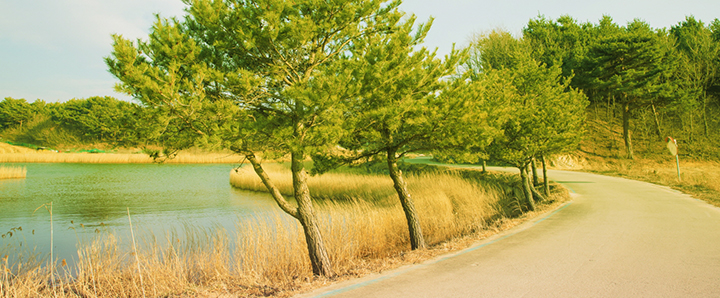
Songjiho LakeGoseong
Songjiho Lake, a representative tourist destination in Goseong with beautiful scenery that blends in with a natural lake and Jukdo Island, does not freeze easily, even in winter, and the water is clear. It is a migratory bird sanctuary for winter migratory birds. You can observe flocks of mallards, wild geese, and swans, a natural monument, at the Songjiho Birding Tower next to Songjiho Lake.
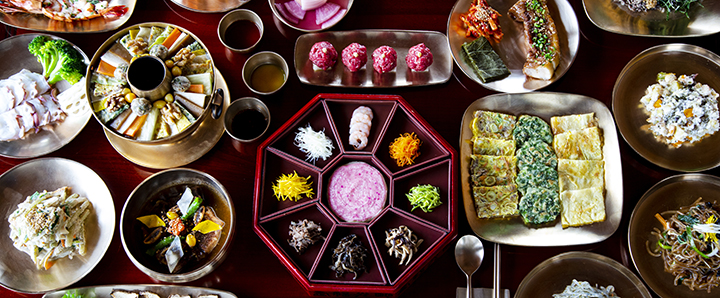
Sanchae Yori (Wild Vegetable Dishes)Yangyang
Wild vegetable restaurants in the Osaek Yaksu (mineral water spring) area of Gangwon-do climb up and down Seoraksan Mountain in all seasons to collect, trim and blanch herbs that grow in abundance every season, dry them well in the sun and store them for use all year round. Depending on the characteristics of the herb, it is seasoned with homemade soy sauce, soybean paste, red pepper paste, or salt, and seasoned with freshly squeezed sesame oil or perilla oil with minimal seasonings such as green onion and garlic to bring out the original taste of the ingredient. Put six or seven kinds of wild herbs in a bowl with rice, add a spoonful of red pepper paste to it, and mix them all to make a sumptuous feast that does not require any other side dishes. (Excerpt from Yangyang Tour)
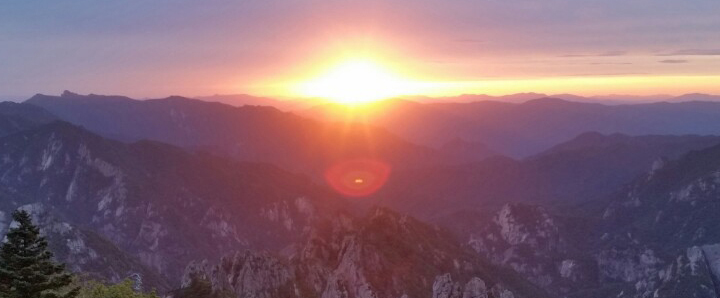
Seoraksan MountainYangyang
You can see the East Sea if you climb up to Ulsanbawi Rock. It is popular among many tourists, and you can climb without hiking boots. It offers colorful scenery in the fall foliage season and white snow scenery in winter.
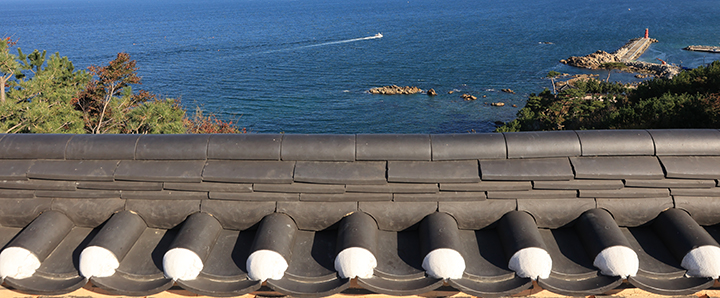
Naksansa TempleYangyang
Naksan Beach is a clean beach that many tourists visit in summer and also all year round for Naksansa Temple. In particular, the sunrise at Uisangdae Pavilion, among the attractions of Yangyang, which is famous for sunrise, is regarded as one of the eight famous spots in Eastern Korea. It is said that it is a place where Great Priest Uisang came to examine the mountain’s terrain after visiting the Buddhist Goddess of Mercy and visited before constructing Naksansa Temple.
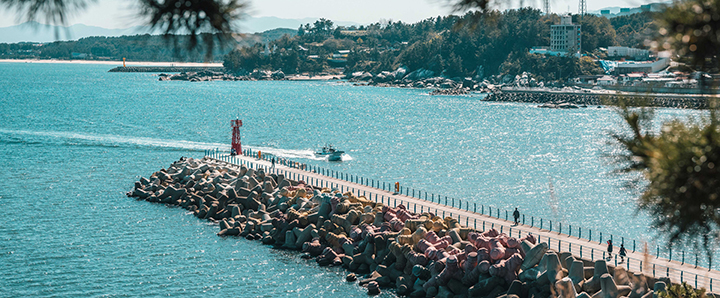
Jukdo BeachYangyang
Silver carpet, two seas, 4km of pine forest, and blue sea. Everywhere you look is dazzling like a masterpiece. There is no carpet as good as the warm sandy beach to appreciate the vast ocean, from the warm sunlight to the smell of the sea you can feel at the tip of your nose and crashing waves.
 최종수정일 : 2022-12-20
최종수정일 : 2022-12-20
